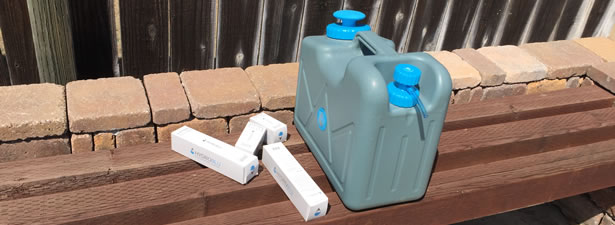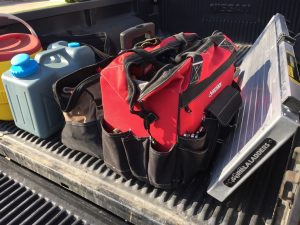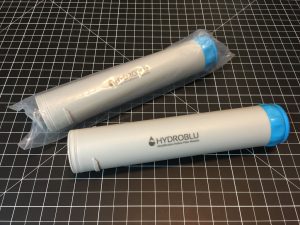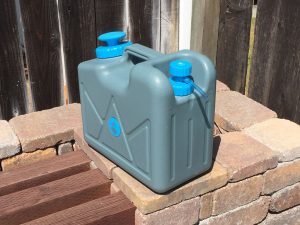HydroBlu Pressurized Jerry Can Water Filter Reviewed

Marketing from HydroBlu
The pressurized Jerry Can was created to provide high quality water quickly and efficiently. It’s internal filtration system along with a hand pump make it easy to filter large amounts of water while camping, traveling, or in the case of emergencies.
The Pressurized Jerry Can Water Filter is lightweight, which allows for easy carry for filling from almost any water source. With a two stage filter system, water taste and clarity are enhanced, while removing harmful bacteria, chemicals, metals, sediments, and other contaminants.
Manufacturer: HydroBlu, hydroblu.com
Model: Pressurized Jerry Can Water FilterCapacity: 4 gallons, 15L
Filters: 0.1 Micron hollow fiber membrane, activated charcoal
Flow Rate: 1 gallon every 3 minutes
Weight (Empty): 4.5 lbsOptions: 0.02 Micron hollow fiber membrane available separately
MSRP: $169.95
The Review
One of the most important considerations in survival is water. And when you are prepping for a family, the issue is only compounded. Each person needs at least one gallon of potable water per day to survive. Obviously, it is not possible for most to store enough water for a long-term emergency situation, and personal water filters are not that efficient. What about small children, or an entire family? I recently came across an interesting solution online from a company named HydroBlu. After reaching out to them, they graciously provided me with one of their Pressurized Jerry Can Water Filters to try out. Stay tuned as we check it out…
 Typical water filters reduce turbidity and remove particulates all the way down to 0.2 microns, thus eliminating most waterborne bacteria including salmonella, cholera and E.coli, and waterborne protozoa including giardia and cryptosporidium. For most water sources in North America, that is all of the filtration that you would likely ever need. In other parts of the world, that is a different story. However, if the grid ever goes down, that could easily change.
Typical water filters reduce turbidity and remove particulates all the way down to 0.2 microns, thus eliminating most waterborne bacteria including salmonella, cholera and E.coli, and waterborne protozoa including giardia and cryptosporidium. For most water sources in North America, that is all of the filtration that you would likely ever need. In other parts of the world, that is a different story. However, if the grid ever goes down, that could easily change.
Higher quality portable water filters tend to be mechanical in nature in order to achieve a higher level of filtration, removing particulates and waterborne pathogens rendering the water safe to drink. Personal filtration straws and gravity-fed systems just cannot build up enough pressure to filter water down to a microscopic level for an extended period of time. And even that has serious limitations, requiring regular backflushing. In mechanical filtration systems, water is forced through the microscopic pores in the filtration medium so they are able to filter more water for a longer period of time.
Simply put, the innovative pressurized jerry can from HydroBlu is a 4-gallon jug with a two-stage water filter built-in. It is capable of filtering particulates, pathogens, and other impurities all the way down to 0.1 microns utilizing the combination of advanced activated carbon, ion-exchange, and hollow fiber membrane technologies. Both of these modules are easily replaceable. However, the long-lasting hollow fiber membrane module is capable of filtering as much as 10,000 gallons of water before it will need to be replaced. Especially if you pre-filter the source water going into the jug, replace the activated carbon module regularly and backflush the hollow fiber module often.
 The first stage of the filtration process is performed by the Activated Carbon Module. The module is approximately 3″ long and 1.5″ in diameter with a flow-rate of 1 gallon every 3 minutes, and will filter up to 250 gallons in most conditions. It contains a pre-filter membrane designed to prevent sediment and other large particulates from entering and fouling the filtration media.
The first stage of the filtration process is performed by the Activated Carbon Module. The module is approximately 3″ long and 1.5″ in diameter with a flow-rate of 1 gallon every 3 minutes, and will filter up to 250 gallons in most conditions. It contains a pre-filter membrane designed to prevent sediment and other large particulates from entering and fouling the filtration media.
Beyond the pre-filter, the Activated Carbon Module contains a mixture of granular activated carbon and ion-exchange microbeads designed to remove chemicals, heavy metals and other unhealthy organic compounds often found in runoff including chlorine, pesticides, and herbicides. The granular activated carbon consists of charcoal from high-quality burnt coconut shells, providing a highly porous surface area. Charcoal is the chosen media because it has the natural ability to attract and absorb chemicals, heavy metals and other impurities from water.
The porous ion-exchange microbeads are made of an organic polymer substrate are designed to provide a large surface area for removing pollutants, poisons, and heavy metals from the water. The ion-exchange part of the process replaces these negative ions with innocuous ions like sodium and potassium. As the water passes over the surface of the activated carbon and ion-exchange microbeads, contaminants are drawn into the pores where they become trapped resulting in clean, odor-free drinking water.
 The final stage of the filtration process is performed by the Ultrafiltration Module. It is approximately 8″ long and 1.5″ in diameter with a flow-rate of 1 gallon every 3 minutes, and will filter up to 10,000 gallons in most conditions. The filter medium is made up of dozens of hollow fiber tubes containing millions of microscopic holes approximately 0.1 micron in size, effectively surpassing EPA standards. 99.999% of all bacteria and protozoa are much larger than 0.1 microns so the hollow fiber filter membrane is able to strip these nasty bugs from the water passing through it using size exclusion.
The final stage of the filtration process is performed by the Ultrafiltration Module. It is approximately 8″ long and 1.5″ in diameter with a flow-rate of 1 gallon every 3 minutes, and will filter up to 10,000 gallons in most conditions. The filter medium is made up of dozens of hollow fiber tubes containing millions of microscopic holes approximately 0.1 micron in size, effectively surpassing EPA standards. 99.999% of all bacteria and protozoa are much larger than 0.1 microns so the hollow fiber filter membrane is able to strip these nasty bugs from the water passing through it using size exclusion.
HydroBlu also has a 0.02 micron hollow fiber membrane replacement module available called the Virus Ultrafiltration Module. It is capable of filtering many viruses like Hepatitis A, Polio, Typhoid and Enteroviruses in addition to the bacteria and protozoa that the standard module filters utilizing the same size exclusion technology. This optional module is exactly the same dimensions as the standard hollow fiber module, but it does have a lower flow rate of 1 gallon every 5 minutes due to the finer filter membrane. However, it too will filter up to 10,000 gallons in most conditions. It is important to note that there are many viruses much smaller than .02 microns, and even though this filter module is much better at catching many viruses, it simply cannot remove all of them.
At any time, the filter modules can be cleaned by sending clean water through the outflow side of the filter, removing sediment and other contaminants that are clogging the filter medium often referred to as backflushing.
 The jerry can is a heavy-walled BPA-free food-grade HDPE (high density polyethylene) container with an over-all capacity of 4-gallons. High-density polyethylene is a polyethylene thermoplastic made from petroleum with a high strength-to-density ratio and exceptional corrosion-resistance. It is a recyclable material often referred to as “alkathene” or “polythene” commonly used to make plastic bottles, corrosion-resistant piping, geomembranes and plastic lumber.
The jerry can is a heavy-walled BPA-free food-grade HDPE (high density polyethylene) container with an over-all capacity of 4-gallons. High-density polyethylene is a polyethylene thermoplastic made from petroleum with a high strength-to-density ratio and exceptional corrosion-resistance. It is a recyclable material often referred to as “alkathene” or “polythene” commonly used to make plastic bottles, corrosion-resistant piping, geomembranes and plastic lumber.
The Jerry Can is approximately 14″ x 8″ x 13″ and has a rugged handle integrated right into the design canister making it easier to carry. And on each of the two sides, there is a plastic cap covering a set of deeply molded indents not only for increasing the structural integrity of the Jerry Can but also to store two spare Activated Carbon Modules. While the canister has structural indents molded into the design, it is not stackable. It is also not designed for long-term water storage. Although, you may be able to store water in it much longer if you removed the filter modules.
On the top of the jerry can, there are two ports; One for the integrated pump, and the other for the filtration module tree that connects to the shut-off valve. The module housings, hand pump, and water outlet valve are all made from acrylonitrile butadiene styrene (ABS). It is a tough thermoplastic polymer, ideal for impervious plastic parts that need to be strong, even at low temperatures.
The pump draws air in, then forces it into the canister, effectively pressurizing it. As the valve is opened, the water is forced through the filtration modules and out the spigot. Similar in nature to one of those fertilizer or pesticide sprayers that you might find at a home gardening center. Each kit comes with two blue vinyl tubes to direct the water further from the top of the canister making it easier to fill your water containers.
 To test the filter, I filled the jerry can with regular tap water. I wanted to see how well it could remove the chlorine from the bad-tasting over-chlorinated tap water that my city dispenses. Normally, I use something like Gatorade to see how well filters can remove the coloring and flavor from the water providing a standard benchmark for measuring filter quality. But the capacity of the canister is just too high for me to justify a test like that.
To test the filter, I filled the jerry can with regular tap water. I wanted to see how well it could remove the chlorine from the bad-tasting over-chlorinated tap water that my city dispenses. Normally, I use something like Gatorade to see how well filters can remove the coloring and flavor from the water providing a standard benchmark for measuring filter quality. But the capacity of the canister is just too high for me to justify a test like that.
After thoroughly rinsing the jug out making sure to remove any grit that could damage the pump. Then I filled it almost all the way to the top before attaching the pump and the valve to the corresponding ports. I made sure to tighten, ensuring the seals were airtight. Next, I pumped the canister up with a dozen or so strokes, stopping once I saw the canister had expanded slightly. A steady stream of clean filtered water left the spigot immediately after opening the valve, and then the flow stopped immediately after closing the valve.
I purged the filter as directed before depressurizing the unit and starting over. I wanted to see just how much filtered water twelve pumps would create. As it turned out, I was able to fill three 16-ounce bottles of water to the brim and one about halfway from those few pumps which show that the pump is very efficient. It is important to note that you should never over-pressurize the unit or leave the jug pressurized for long periods of time to reduce the likelihood of any possible damage to the seals throughout the unit.
 The water actually tasted pretty good after it was filtered. The nasty chlorine smell and taste was completely gone. In fact, I really couldn’t taste much of a difference between the water that was filtered by HydroBlu’s filter and water from my Berkey Filter.
The water actually tasted pretty good after it was filtered. The nasty chlorine smell and taste was completely gone. In fact, I really couldn’t taste much of a difference between the water that was filtered by HydroBlu’s filter and water from my Berkey Filter.
After filling the water bottles, I did something that I now regret very much… I wanted to see just how durable the Jerry Can was. However, it was pressurized with 30-pounds of water in it. But, I knocked it off the picnic table where I was testing it anyway. Of course, it landed hard on one of the corners. I shouldn’t have expected any less. Thankfully the container did not crack, but it did crease significantly at a weak point in the sidewall. Bottom line… Don’t let it fall from any height when it has a significant amount of water in it.
After bleeding off the unused pressure, I immediately rinsed and emptied the container out completely. It is recommended by the manufacturer not to let the filter media dry out completely due to the crystallization of hard water. However, after doing this with many other filters in the past, more often than not I found them rank and full of mold when I needed them most. I’ve always had the most success from rinsing them out with vinegar and distilled water, then letting them dry out completely before packing the filter away. This would prevent any mold or bacteria from growing inside when they are not in use. If I had been using the Jerry Can for any length of time, I would have also considered backflushing it before drying it thoroughly and putting it away.
Final Thoughts
The Pressurized Jerry Can Water Filter is made from high-quality materials, utilizing a combination of activated carbon and innovative hollow fiber filtration technology. The technology behind this type of filtration is solid, having been used and thoroughly tested for decades in commercial, residential and portable filtration systems. One clear advantage that the Pressurized Jerry Can Water Filter has over single-stage filters like most straws and gravity-feed systems is the additional stage of filtration that provides a way to improve the smell and taste of the water in addition to the removal of the dangerous chemicals and heavy metals. The activated carbon module is key.
Of all of the different kinds of filters and filtration systems that I’ve used and tested, not one of them have ever included a rugged storage reservoir like the Pressurized Jerry Can Water Filter. The unit and replaceable filter modules are a bit expensive. But they are no more expensive than any other higher-end filtration unit. When you are caring for a family in a situation where clean potable water is not readily available, having a water filtration unit like this along with you is a complete game-changer. Two thumbs up!
For this and other HydroBlu products, visit Amazon here.
![]()
About HydroBlu
 Founded at the base of the Wasatch Front mountain range in Utah, we have the perfect proving grounds for water filtration. We are outdoor enthusiasts, hikers, backpackers, and survivalists, and love being outside. Our goal is simple. We wanted to create a water filter that we would use and not break the bank to buy.
Founded at the base of the Wasatch Front mountain range in Utah, we have the perfect proving grounds for water filtration. We are outdoor enthusiasts, hikers, backpackers, and survivalists, and love being outside. Our goal is simple. We wanted to create a water filter that we would use and not break the bank to buy.
--